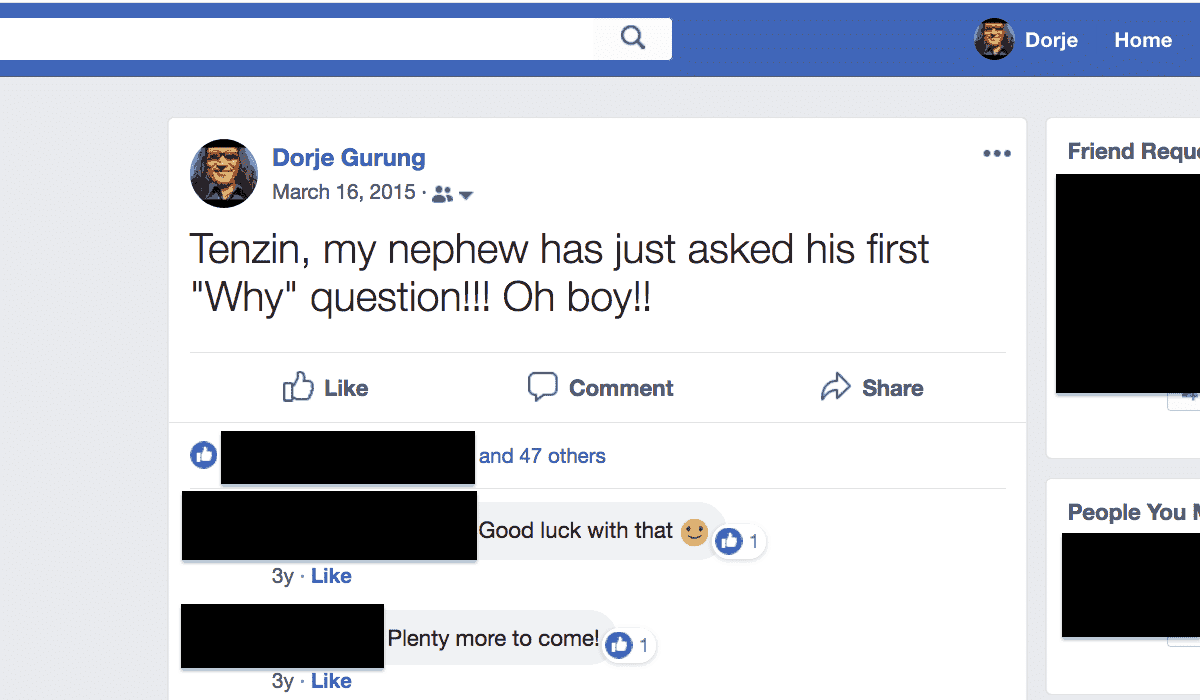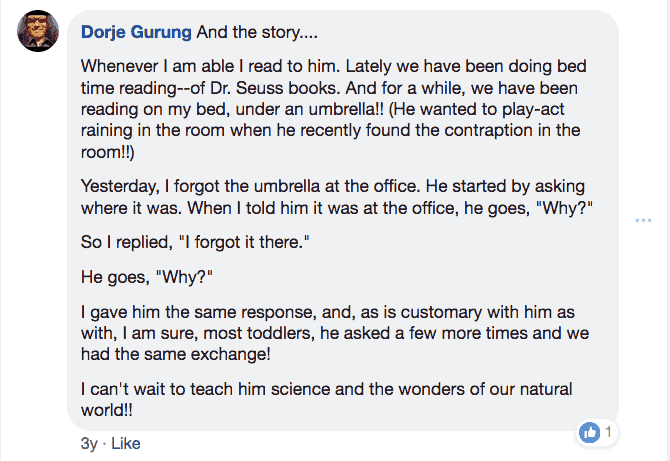
One of the numerous amazing things to observe in a child when raising them — as I have done with my little nephew — is seeing them discover questions.
Even so, none of the where, the what, the when, and the how questions stick with them as much as or for as long as the why questions! If you have raised children you know what I mean when I say once they learn to ask why questions, it’s like that’s all the kind of questions on a toddler’s tongue AND just all ready to roll off one after another all the time! And even the answer to the original why question is followed up by “Why?” and the response to it also by “Why?” and so on!
According to Facebook (see header image), March 16, 2015 was when my little nephew asked his first why question. A comment under the post describes the exchange further.
We, humans, ask “Why?” because we are born curious.
The challenge for adults when children ask such questions is to respond appropriately, not only in a way that the children understand or in a way that makes sense to their still-developing and growing minds, but also in a way that encourages them to continue asking them.
One of the points, if not THE point, of education is to nurture and foster that innate curiosity in children by CATERING to it!
But unfortunately, both informal and formal education systems in Nepal are such that, far from encouraging it, we kill it! Our child-rearing culture, school culture, and the quality of our education system are such that, far from nurturing, fostering, and thereby keeping alive that innate curiosity, we make (even force?) children to suppress them (as also with their imagination), little by little, until it disappears.
My theory is that when they are in 5th or 6th grade (when they are about 10 or 11) that the suppression is complete for most, that innate sense of wonder about the world around them ceases for most. 🙁 🙁
For most, that’s a year or two before they hit puberty, which, as far as I am concerned, is yet another major issue!
Since returning to Nepal, I have given talks in Nepal and outside the country, sometimes in the form of a formal multi-media presentation and other times just informally. I have presented about life in general, about my life, about education and my work, about United World College scholarships, and about human rights and education of marginalized Nepalis, about voluntourism at orphanages in Nepal, about teaching critical thinking skills etc.
In Nepal, when the audience consisted of only children, whether young eighth graders or much older, or, whether they were private or public school students, without fail they struggled to ask questions during the Q&A session following the presentation regardless of the topic.
Q&A sessions following pretty much every single presentation I have made in Nepali schools have been pretty much the same as the first presentation I ever made: I have had to cajole, goad, and even coax them for questions.
I have been pondering over this again as, in my recent school visits as part of the teacher training program, I once again noticed children in grades 7 and up asking very little why questions! During a recent session with children from 8th to 10th grades, numbering a little over 30, at a small private school, I asked them to raise their hand if, during a lesson, they generally have questions they want to ask their teacher but never do because they don’t feel comfortable.
ALMOST EVERY SINGLE HAND went up!
It’s not that Nepali children aren’t curious; of course they are. We have created a school culture where asking questions — one of the most important things students can/should do in a classroom — is discouraged! 🙁 🙁
My audience outside of Nepal of course were very very different, no different from the students I taught in the past, at international schools around the world: they asked all kinds of questions including why questions.
As a matter of fact, “Why?” were the MOST asked variety of questions by my international students, not surprisingly! And, again not surprisingly, there were many why questions that I didn’t know the answer to, which I would encourage them to find on their own!
That the Nepali children’s ability and tendency to ask why questions is beaten out of them — with some literally — before they hit puberty, I think, can have devastating consequences.
Puberty is probably one of the most — if not THE most — physically, emotionally, intellectually and psychologically transformative and, in many ways, unsettling experience a child goes through. It posses a lot of challenges for a child, especially for girls. But all that could be a whole different blog post all together.
Suffice it to say that involving such dramatic changes, I am sure children going through puberty have question after question after question, some very intriguing and some possibly even troubling ones. I know I did when I was going through it. Unfortunately, in the case of most Nepali children with no one to pose them to.
One important thing I have learned from my education, work, life, and travels around the world is that one should ask questions of others and oneself, and seek and demand answers! If NOT…ask questions because sometimes they are the answers!
I have also discovered that those who should be, and stand to benefit the most from being, most open to challenges to their personal, religious, social, cultural or traditional beliefs, values, and practices, are the least!
Forget Nepali children asking questions, forget Nepali adults asking questions and demanding answers, I have had Nepali adults, some even middle-aged Nepali friends, get offended (and some even angered) by my challenges to, or questions about, their opinion, their attitudes, our culture, our country, our religion, our beliefs, or our practices etc. No wonder school children don’t feel comfortable asking questions of teachers, forget about “Why?” questions.
The reasons behind our school “teaching” our children and our culture “teaching” us Nepali adult to NOT ask questions have to do partly with both the history of our education system and the history of our country, a little too involved to go into the details here.
Regardless, the only way around it is education itself, of course, but quality education!
Quality education that imparts critical thinking skills and thereby caters to the innate curiosity in our children. But given the only skill our extremely corrupt education system imparts is the ability to regurgitate facts and figures, the most basic of skills, unless the system is completely overhauled, the chances of that happening is small, even minuscule.
In the mean time, I have done my best to cater to my little nephew’s curious mind and to keep alive his desire to learn about the world by answering every single one of his why questions. As a matter of fact, just last Saturday, driving home, noticing I had driven really close to a wall, he had asked, “Why did you go so close to the wall?” I had done so to avoid going over a man-hole that had been worked on and that’s exactly what I told him.
If you lose your sense of wonder about the world — about everything and everyone around you and beyond, about everything that happens and doesn’t etc. — what is left to wonder about?!
What do you think?
* * * * * * * *
References
The following were added after the publication of the blog post because of their relevance.
Nepali Times (Sept. 14, 2018). After quantity, Nepal’s education needs quality. “Inadequate training of teachers and over-reliance on defective textbooks keeps learning sub-standard.” [Added Sept. 20, 2018.]
Nepali Times (Aug. 7-13, 2015). U r welcome, wanna cu ASAP 4 a drink. “Textbooks in Nepal’s schools aren’t just outdated, they are outrageously bad.” [Added Sept. 20, 2018.]
Kantipur (Aug. 6, 2018). अनुसन्धानमै बित्यो एक वर्ष | (A Year Gone Already in Investigation). This is about the corruption case Commission for the Investigation of Abuse of Authority has brought against Sajha Prakashan, public publishing house that produces all the textbooks public educational institution around the country use. “कर्मचारीका अनुसार [महाप्रबन्धक डोलिन्द्रप्रसाद] शर्माकी श्रीमतीको नाममा रहेको अक्सफोर्ड पब्लिकेसन र समिसम प्रकाशन नामक संस्था शर्माकै रहेको र समान प्रकृतिको संस्थाका सञ्चालक साझा प्रकाशनमा पदाधिकारी बन्नु नियमवालीविपरीत छ ।” [Added Sept. 20, 2018.]
Setopati (Dec. 22, 2017). ‘अरु’ जे गर्नू, परिवारको नाक नकाट्नू. Excellent piece by @durgakrk about the issues with the lack of proper sex education in Nepal, its consequences, and how to address some of them. [Added Oct. 30, 2018.]
Family (Sept. 20, 2018). How Puberty Kills Girls’ Confidence. “In their tween and teenage years, girls become dramatically less self-assured—a feeling that often lasts through adulthood.” [Added Oct. 30, 2018.]

